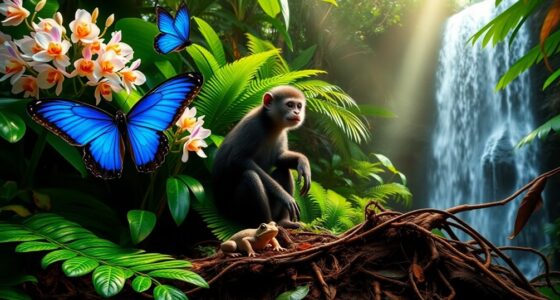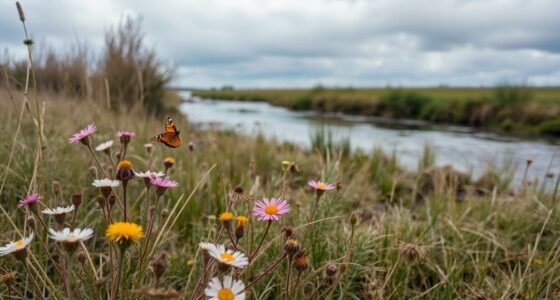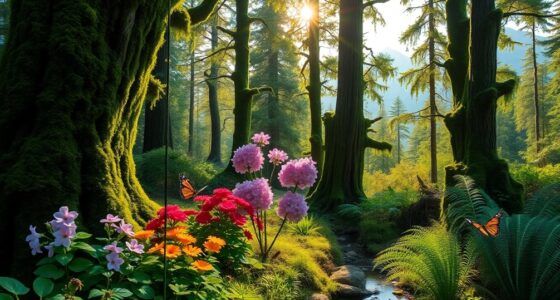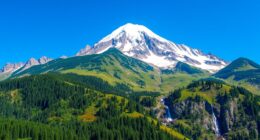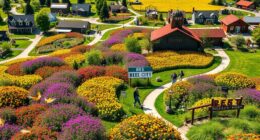Imagine a world where certain animals quietly hold entire ecosystems together. These keystone species play vital roles that keep nature balanced and thriving, often in ways you might not immediately notice. Understanding their importance reveals how fragile ecological systems can be and why protecting these animals is crucial. The stories of these species are more than just fascinating—they’re essential to the health of our planet. Want to see how they do it?
The Role of Sea Otters in Kelp Forests
Sea otters play a crucial role in maintaining the health of kelp forest ecosystems. By preying on sea urchins, they prevent urchin populations from exploding and overgrazing kelp beds. Their high metabolism requires them to consume large quantities of food, primarily sea urchins, which helps regulate these populations effectively. Without sea otters, urchins would multiply rapidly, decimating kelp forests and disrupting the entire ecosystem. This balance supports a diverse range of marine life, from fish to invertebrates, which rely on kelp for shelter and food. Your presence as a keystone predator helps keep these ecosystems resilient and productive. When sea otters thrive, kelp forests flourish, providing oxygen, trapping carbon, and supporting biodiversity. Their role highlights how a single species can shape the entire marine environment, emphasizing the importance of protecting these vital animals.
Beavers: Nature’s Engineers and Habitat Creators
Beavers are remarkable engineers whose activities transform landscapes and create vital habitats. When you observe a beaver building a dam, you see a master architect at work, blocking streams with logs and mud.
This process floods areas behind the dam, forming ponds that serve as homes and safe refuges. These ponds also support diverse plant and animal life, from waterfowl to fish.
By controlling water flow, beavers help regulate stream levels, prevent erosion, and maintain water quality. Their engineering alters ecosystems, fostering increased biodiversity.
Without beavers, many habitats would vanish, reducing the number of species they support. Their natural construction skills demonstrate how a single species can shape entire landscapes, highlighting their importance as keystone species in maintaining ecosystem health.
The Impact of Wolves on Ecosystem Balance
Wolves play a crucial role in maintaining the balance of ecosystems by controlling prey populations and influencing the behavior of other animals. When wolves hunt deer and elk, they prevent these populations from overgrazing vegetation, which helps preserve plant diversity. This, in turn, benefits other herbivores and the entire food web. Wolves also cause prey animals to change their movement and feeding patterns, reducing overuse of certain areas and fostering healthier ecosystems. Their presence can lead to more balanced predator-prey dynamics, which stabilizes populations across multiple species. By keeping prey numbers in check, wolves prevent overpopulation and habitat degradation. This ripple effect enhances biodiversity, strengthens ecosystem resilience, and maintains the natural harmony that keeps ecosystems thriving. Healthy ecosystems rely on biodiversity to function effectively and adapt to environmental changes.
Starfish: Regulators of Marine Biodiversity
Starfish play a vital role in maintaining marine biodiversity by regulating the populations of their prey, particularly mussels and barnacles. By preying on these species, you prevent them from overgrowing and dominating the habitat, which preserves space and resources for other marine life. Their predation activity helps maintain a diverse and balanced ecosystem. When starfish keep mussel numbers in check, it encourages a diverse array of species to thrive, supporting a balanced ecosystem. Without starfish, mussel populations could explode, smothering other organisms and reducing overall biodiversity. You mightn’t realize it, but starfish act as natural gardeners, shaping the structure of the seabed. Their predation maintains healthy community dynamics, ensuring that no single species becomes dominant. In this way, starfish help sustain the complex web of life beneath the waves, demonstrating their importance as keystone species that uphold ecological stability.
African Elephants and the Shaping of Savanna Landscapes
African elephants are often called “ecosystem engineers” because their behaviors dramatically shape savanna landscapes. As they move through the terrain, they knock down trees and uproot shrubs, converting dense woodlands into open grasslands. This activity creates space for grasses and smaller plants, promoting biodiversity and supporting herbivores like zebras and wildebeests. Their impact extends to the overall ecosystem health, ensuring the sustainability of diverse species within the savanna. Elephants also dig waterholes, which benefit not only themselves but other animals during dry seasons. Their trampling helps disperse seeds, facilitating plant growth and diversity. Without elephants, the balance of the savanna shifts, risking overgrowth of woody plants and reducing available habitat for many species. Their influence is vital in maintaining the savanna’s dynamic equilibrium, demonstrating how these giants hold the ecosystem together through their impactful behaviors.
The Keystone Role of Prairie Dogs in Grassland Ecosystems
Have you ever wondered how a small rodent can have such a big impact on its environment? Prairie dogs are a perfect example. These tiny creatures dig extensive burrow systems that aerate the soil, boosting plant growth and water absorption. Their digging also creates habitats for other animals like burrowing owls and snakes. Prairie dogs selectively feed on grasses, helping control plant dominance and promote biodiversity. Their presence influences predator populations, attracting foxes and hawks that rely on them for food. Without prairie dogs, grasslands risk overgrowth of certain plants, leading to less diverse ecosystems. Their activities maintain the balance of grassland communities, making them true keystone species. Additionally, their interactions with other species highlight the importance of ecosystem balance in maintaining healthy environments. You can see how these small animals play a massive role in shaping thriving, resilient ecosystems.
Coral Reefs and the Guardians of Biodiversity
Did you know that coral reefs support more species than any other marine ecosystem? These vibrant structures act as underwater cities, providing shelter, food, and breeding grounds for a vast array of marine life. As a keystone species, corals stabilize ecosystems by building complex habitats that many other creatures depend on. Without corals, countless fish, invertebrates, and algae would lose their homes, leading to a collapse in biodiversity. You can think of corals as guardians of marine health, ensuring the survival of diverse species. Their presence helps maintain water quality, control algae overgrowth, and support food webs. Protecting coral reefs is crucial, not just for the species that live there, but for the health of the entire ocean ecosystem. The materials used in unique and wicked planters can inspire eco-friendly solutions to reduce damage to these vital habitats.
Sea Birds and Their Influence on Coastal Environments
Sea birds play a vital role in shaping coastal environments through their feeding and nesting behaviors. When they hunt for fish and invertebrates, they help control populations that could otherwise overrun the ecosystem.
Their nesting sites, often on cliffs or islands, influence vegetation growth and soil stability by disturbing plants and depositing guano, which enriches the soil with nutrients. This nutrient input supports plant life and attracts other animals, creating a vibrant, interconnected habitat.
Additionally, when sea birds disperse seeds or carry nutrients inland, they extend the influence of coastal ecosystems further into terrestrial areas. Their activities help maintain the delicate balance of coastal environments, making them essential keystone species that hold these ecosystems together. Moreover, their presence can encourage Volkswagen Tuning enthusiasts to appreciate the importance of ecosystems’ balance and sustainability.
Without sea birds, coastal habitats would face significant ecological shifts.
Conclusion
You see how these keystone animals keep ecosystems thriving. By controlling prey, building habitats, or shaping landscapes, they ensure biodiversity and balance. Protecting species like sea otters, beavers, wolves, and others isn’t just about saving animals — it’s about safeguarding the health of entire ecosystems. When these creatures flourish, the web of life stays strong. Your efforts can help preserve these vital species and keep nature’s intricate systems working smoothly.

